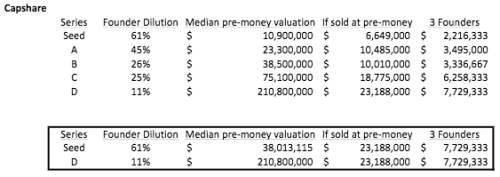Meaningful Exits for Founders
For an industry that doesn't do it for the money, we sure talk about money an awful lot in the world of startups.
A few posts were written this past week diving deeper into the numbers that drive VC returns which, in turn, drive behavior in startups who've raised money from VCs.
One post, written by Samuel Gil, outlined what is considered a meaningful exit for VCs. According to Sam's math, a meaningful exit for a fund should have the ability to return 33% of a given VCs fund, a "home run" exit should be able to return their entire fund in a single investment.
This is a helpful visual he put together to show the resulting math behind meaningful exits at various fund sizes:

Across all of these scenarios, the smallest meaningful exit for the tiniest fund is a purchase price of $85M.
Now, we don't know much in this scenario beyond the 20% owned by one fund. We don't know how many rounds this company has raised, how many other VCs are on the cap table, nor how much the founders own.
(sidebar- most $50M funds would kill for 20% ownership these days. 5%-10% range is much more likely after the initial round of funding and dilutes rather quickly in successive rounds as reserves for pro rata vary wildly by firm).
Another post from Capshare surfaced this week touching on that last bit about founder ownership at various levels of VC funding. Specifically, this post highlighted, after having analyzed over 5,000 VC backed cap tables, that founder dilution is fairly predictable based on the rounds raised by a given company. There are plenty of graphs to pour over in the post, but the summary reads as follows:
If your company exits around Series D, you can expect the following splits:
Founder ownership: 11-17%
Other employees: 17-21%
Investors: 66-68%
The data suggests startups generally have 2-3 founders so divide that number by the number of founders, and that's the predictable founder ownership level of a Series D funded company (in the Capshare post the Series D valuation was $210M).
Reframing those numbers another way, a founder selling at the Series D price of $210M, would make the same amount of money at exit as they would have if they'd sold for $38M after having only raised a seed round.

Lifetimes of work and risk lie between a Seed round and a Series D round. And, despite increasing the value of the underlying business 7x, the dollars at exit for the founder remain roughly the same. It is also worth noting that an exit at $210M would not even qualify as a home run for even the smallest fund in Sam's examples.
There are many paths to managing dilution- be it raising fewer rounds at higher and higher valuations, or raising one round and scaling a business on revenue and profits generated from customers.
Through our work on Indie.vc we've met many founders who've raised successive rounds of funding and had opportunities to exit their businesses for life changing sums of money; however, those acqusition offers were not meaningful exits or homeruns for their investors.
Many are looking to avoid, or at least be more aligned, with investors on the companies they are working on now. As Marc Hedlund wrote in his post about why Skyliner chose to work with us:
It should not be surprising that we chose to work with
Indie.vc. It's a choice many more entrepreneurs should make, whether you have tons of experience or are just starting out. Don't let the normal VC business model drive your work into a low-probability, high-reward outcome, when a higher-probability outcome is well within your reach, especially one that does nothing to limit your growth.
So, let's keep saying we don't do it for the money.
Fine.
But, it might be worth looking more closely at the numbers before so quickly trading what's a meaningful exit to a founder for what's a meaningful exit to a VC.
source: Medium